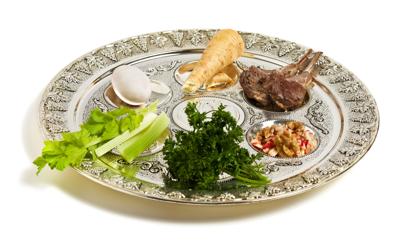|
 The Seder Plate The Seder Plate
The Seder Plate holds six traditional foods that will be used throughout the Seder. These foods are:
1. Beitzah – The Hard Boiled Egg. This is symbolic of the ritual sacrifice that was made on Passover in the Temple. Since the destruction of the Temple there is no place to make the sacrifice therefore an egg is used in its place. Many also believe this represents the enduring nature of the Jewish people and the generations that have been created and will be created since the time of the Exodus. This is eaten before anything else during the Seder.
2. Zeroa – The Shank Bone. It is usually roasted lamb, although many families use chicken, with most of the meat removed before placing it on the Seder Plate. It is not eaten; it serves as a reminder of the sacrifice of a lamb made the night before the Israelites fled Egypt. And the blood put on the doorposts so Angel of Dead would spare the Israelites' first born.
3. Maror – Bitter Herbs. The most common is Horseradish or Romaine Lettuce, however, endives or scallions are also used. The bitter herbs are washed and put on the Seder Plate plain – no adornment is permitted. When first eaten they do not taste bitter, but leave a bitter aftertaste. This represents the Israelites’ experience in Egypt. Eating the Maror is one of the most important parts of the Seder. While we eat we remember that we are now free but the Israelites lived in harsh conditions as slaves. And we reflect on what we can for those in the world who are suffering and not free.
4. Karpas – The Vegetable. This is usually parsley but can also be celery or a boiled potato. It is eaten by dipping it into salt water right before we begin the story of the Exodus. This represents the 600,000 Israelite males who were in servitude in Egypt. Karpas means celery in Hebrew and is spelled כרפס. Spelled backwards it bears the symbolic meaning of this food. The letter "ס"(samech) represents the number 60 and פרך “perech” means servitude. The salt water represents the tears of the Israelites.
5. Charoset – The Sweet Paste. This is a mixture of apples, pears, nuts and sweet wine all crushed together to form a paste. It is eaten with the Maror, but just a little as the sweetness of the Charoset should not overpower the bitterness of the Maror. The Charoset represents the motar the Israelites were forced to use while build for the Egyptians.
6. Hazeret –More Bitter Herbs. This is a revisit to the bitter herbs from the beginning of the Seder. The word Hazeret, which literally means horseradish, is related to the Hebrew word “hazra” which means repeat.
The Kiddush Cup and Wine
During the Seder we drink four cups of wine. The wine should be kosher. The ceremonial cup that the wine is poured into is called a Kiddush Cup. In some families only the head of the Seder table drinks from the Kiddush Cup and in others everyone at the table takes a sip. Everyone should have their own cup of wine as well.
The four cups represent four expressions of redemption written in Exodus 6:6-7. These expressions are represented as such: the first cup “and I removed you” (physically from Egypt); the second cup “and I freed you” (from the bonds of slavery); the third cup “and I redeemed you (with outstretched arms and mighty acts); and the fourth cup “and I took you” (as G-d’s own people).
|






